MARIANI’SVirtual
Gourmet
July
17,
2011
NEWSLETTER
❖❖❖
This Week
Palm Beach, Part One: The Breakers
by Edward Brivio
New York Corner: A Star Chef from Italy visits the Big Apple
by Edward Brivio
Man About Town: Loudoun County, Virginia
by Christopher Mariani
Notes From The Wine Cellar: Hennessey's $5 Million Nose
by Mort Hochstein
Mariani's Quick Bytes
If you would like to featured in
our Quick Bytes section please visit our advertisement page at www.JohnMariani.Media.com
|
Australian
Perigord Truffles
AUSTRALIAN
PERIGORD TRUFFLES, The Trufferie in Manjimup is unearthing
some of the most potent Perigord aroma that eclipses most of what is
found in the European winter. The Chefs Diamond Company www.thechefsdiamond.com
suppliers to this Countries most renowned Chefs, has just recently
started selling Fresh Truffles to the retail Market, Private Chefs and
Foodies please visit our online store for what's sure to leave you
captivated... These Perigord Truffles are not to misinterpreted, Yes
they are available fresh and YES they are The True Perigord Spore.. For
more info visit the Farm Down Under www.wineandtruffle.com
Chefs please call King Truff 219-798-5662 or email kingtruff@gmail.com |
|
New York
Celeb Chef at French Revolution Festival in Riviera Maya, July 11 - 23
From July 11-23, a festival
honoring the anniversary of the French Revolution will be held at AAA
Five Diamond Grand Velas Riviera Maya. The resort's gourmet restaurant
Piaf will be showcasing the talents of New York City's
Madison
Bistro owner and Maitre Cuisinier de France, Chef Claude Godard.
Alongside Piaf's Executive Chef Michele Mustiere, Chef Godard will
prepare a 5-course tasting menu featuring Sautéed Foie Gras w/
Artichoke Mousseline and white truffle; Hazelnut-butter Roasted Sea
Bass, and a decadent chocolate dessert served with poached raspberries.
Available to resort guests at no charge, $1200 pesos (approx. $100USD)
for non-hotel guests. 1-888-323-2776; velasresorts.com. |
|
Terrific Read! -- The Last flight of
Jose Luis Balboa
Set in Miami, Gonzalo Barr's "The Last flight of José Luis
Balboa" vividly captures a city defined by the blur of cultures. The
L.A. Times Book Review wrote that the "stories sparkle." And The Times
Literary Supplement (London) called it a "brilliant short story
collection." It is a great read for the summer, even if you can't make
it to South Beach." To purchase, visit Amazon.com |
|
OpenSkies Extends Summer
Impromptu Sale!
In honor of the
Fourth of July and Bastille Day, OpenSkies, the transatlantic all
business airline offering guests superior service and competitive
fares, has extended an exciting,
limited-time offer that will allow customers to travel between Paris
and the U.S. in the ultimate luxury and comfort at an incredible value.
OpenSkies’ impromptu summer saver fare allows travelers to
fly from Washington, D.C.-Dulles to Paris for $699 each way and from
New York-Newark to Paris for $799 each way. This special offer is valid
on any roundtrip Biz Seat business class ticket booked by July 15 for
travel between July 10, and September 10, 2011. OpenSkies is also
offering the Independence Summer Saver promotion - $200 off a roundtrip
fare – for travel from New York-Newark or Washington D.C.-Dulles to
Paris. This special offer
is valid on any roundtrip, Biz Seat or Biz Bed business class ticket
booked (with the promo code JULY200) by July 17, 2011, for travel
between July 1 and December 31, 2011. Visit www.flyopenskies.com |
Place your Quick
Byte Here
|
by Edward Brivio
Photos by Robert
Perillo
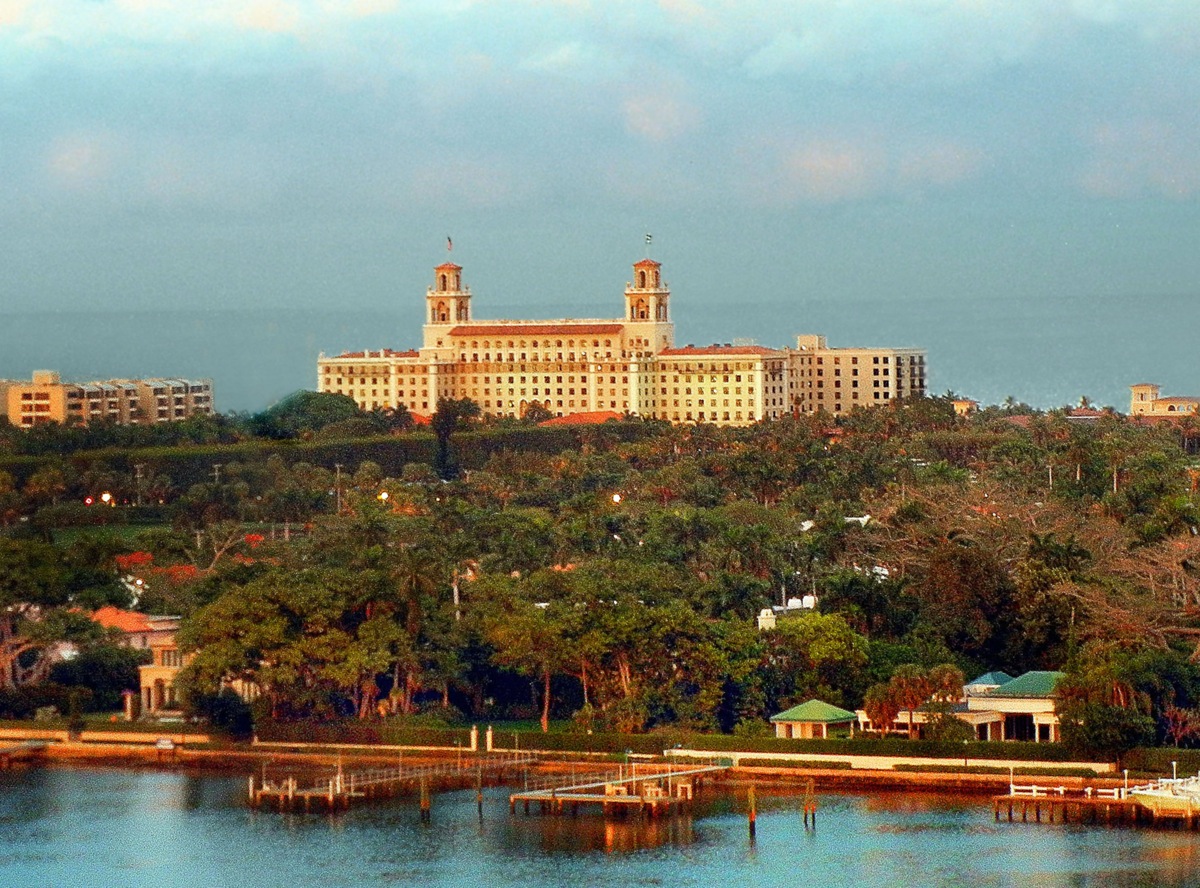
The Town of Palm Beach may be
celebrating
the centennial of its incorporation this year, but the origins of the Breakers
go back even further. Originally called the Palm Beach Inn, built
by Henry Morrison Flagler in 1896 in what was then still
part of the town of Lake Worth. For a very long time
thereafter, the history of
Palm Beach was the history of Breakers, so that I can’t
imagine a visit to the
area without paying some attendance upon the Grande Dame of the
town, still the unrivaled
jewel in
its crown.
Built when good taste was rampant amongst the “happy few,” The Breakers remains a masterpiece of Italian workmanship and one of the finest examples of that Mediterranean Revival style in architecture still found in so many of Palm Beach’s beautiful mansions. But, make no mistake, family-held by the heirs of Flagler’s last wife, Mary Lily Kennan (for whom he built the mansion, Whitehall), the Breakers is no lost-in-the-past Miss Havisham. Beneficiary of an annual $25 million makeover to keep her youthful, the resort is as fresh as the day late in 1926 when this third, and final, attempt at getting a foothold on the Atlantic opened after only 11 months of construction.
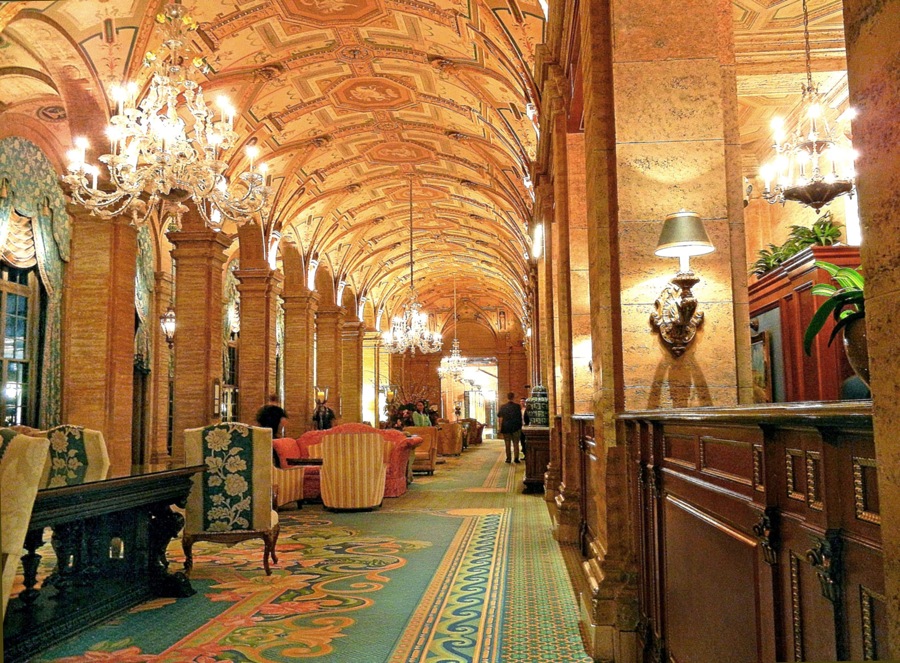 "Fare la bella figura" goes
beyond skin deep at the Breakers. Not only has the façade been
brought back to
something like its original glory, but the latest round of guestroom
renovations is now nearing its end. I don’t know how many
upgrades it’s seen
since opening in 1981, but it’s hard to believe that the Flagler Club,
a 27
room boutique-hotel on the resort’s top two floors, is already 30 years
old. It always
looks as though it had just opened, especially the lounge on six, whose
loose,
residential sprawl of comfortable armchairs and sofas look like they’d
just
been upholstered. On the Concierge Level, Chef Concierge Bernard
Nicole,
to
me,
is
the Flagler Club and an important part of it since day one. Bernard
brings a bit of the posh, casual elegance
of the sun-drenched Côte d’Azur to the Gold Coast of Florida. For
three
decades, the suave Mr. Nicole, with his charming Antibois
accent is as much a part of the pleasure of staying here as the other
amenities offered,
including continental breakfast, late-morning refreshments, afternoon
tea, pre-dinner hors-d’oeuvres and bar service, and, finally, desserts
and after
dinner drinks on a large terrace facing Lake Worth, in its
center a
colossal quatrefoil market umbrella surrounded with finely made patio
furniture and tastefully decorated
guestrooms facing either East or West, as crisp and bright as the
daylight
that floods them.
"Fare la bella figura" goes
beyond skin deep at the Breakers. Not only has the façade been
brought back to
something like its original glory, but the latest round of guestroom
renovations is now nearing its end. I don’t know how many
upgrades it’s seen
since opening in 1981, but it’s hard to believe that the Flagler Club,
a 27
room boutique-hotel on the resort’s top two floors, is already 30 years
old. It always
looks as though it had just opened, especially the lounge on six, whose
loose,
residential sprawl of comfortable armchairs and sofas look like they’d
just
been upholstered. On the Concierge Level, Chef Concierge Bernard
Nicole,
to
me,
is
the Flagler Club and an important part of it since day one. Bernard
brings a bit of the posh, casual elegance
of the sun-drenched Côte d’Azur to the Gold Coast of Florida. For
three
decades, the suave Mr. Nicole, with his charming Antibois
accent is as much a part of the pleasure of staying here as the other
amenities offered,
including continental breakfast, late-morning refreshments, afternoon
tea, pre-dinner hors-d’oeuvres and bar service, and, finally, desserts
and after
dinner drinks on a large terrace facing Lake Worth, in its
center a
colossal quatrefoil market umbrella surrounded with finely made patio
furniture and tastefully decorated
guestrooms facing either East or West, as crisp and bright as the
daylight
that floods them.
Our Flagler
Club
Island View Room, in restful pale green, contained two luxuriously
appointed, very comfortable, queen-size beds, a sofa and coffee table,
as well
as a bathroom from out of a dream, spacious, marble-clad, with double
sinks, a
deep tub 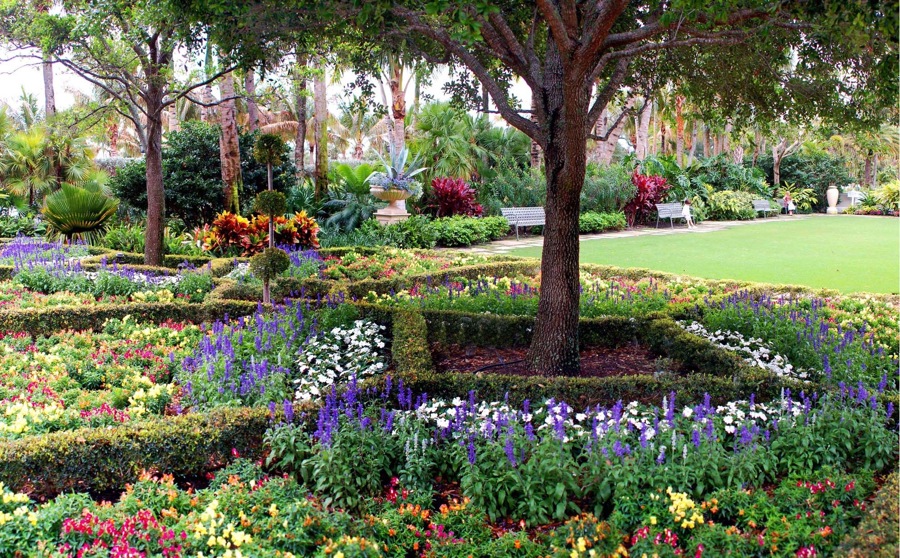 and glass-enclosed shower, fluffy bathrobes and bright
white Turkish
towels.
and glass-enclosed shower, fluffy bathrobes and bright
white Turkish
towels.
Everywhere you turn at the Breakers, you‘re met with good will. Smiling faces welcome you, eager hands ease you on your way, as a large, personable service staff strives to fulfill your every wish. Family-run, in this instance, means employees who are well taken care of so they can enjoy their work: well-rewarded, empowered employees, who are thus able to bring their own personal flair and confident grace to their daily tasks.
After a recent $15 million redevelopment of the beachfront here, the Beach Club, with its extensive, multi-leveled deck, just a few steps off the sand, is now a series of pathways leading to five pools and four whirlpools, with their attendant chaises-longues, cabanas, and beach bungalows right on the ocean, as well as the Ocean Grill restaurant. We head right for the Relaxation Pool--as far down the beach as you can go in one direction--where horseplay is banned and quiet expected. Here, too, are the luxurious beach bungalows, “the ultimate cabana," each with living room, bathroom, indoor and outdoor showers, and private patio. How sweet it was to spend the day on the patio, sunscreen-swathed, and alternating dips in the pool, with sorties into the ocean, and serious down-time, reading and dozing off on one of the lounge chairs. One afternoon we had an unexpected guest, a sleek, slender cormorant, young enough to mistake the pool for his usual fishing grounds, making the most graceful arabesques with his long, supple neck as he dived, before finally flying away to the real ocean nearby.
Follow one of
the
pretty garden paths here to the family-friendly Italian Restaurant
(below), with
terra cotta walls above exposed brick, durable hardwood floors, roomy
tables
and sturdy ladder-back chairs, with even a children's playroom, plainly
visible from the
dining room. Don’t confuse “family-friendly” with mediocre or slapdash, however; as with all the
dining
choices at the resort, whether the haute cuisine contemporaine of
the
elegant
L’Escalier, the fresh catch of the day at the informal
Seafood
Bar, the refined fare at the newest venue, Top of the Point, or yummy
breakfasts in the exquisite, truly magnificent Circular Dining Room,
standards
are everywhere consistently of the highest order.
“family-friendly” with mediocre or slapdash, however; as with all the
dining
choices at the resort, whether the haute cuisine contemporaine of
the
elegant
L’Escalier, the fresh catch of the day at the informal
Seafood
Bar, the refined fare at the newest venue, Top of the Point, or yummy
breakfasts in the exquisite, truly magnificent Circular Dining Room,
standards
are everywhere consistently of the highest order.
At
the
Italian
Restaurant,
pasta e
fagioli was
delicious,
prepared
with
care--both
the
ditalini and white beans, cooked al dente, the
tomato
“broth” fresh and vibrant, the bits of pancetta crisp
and tasty. Insalata
caprese, fresh bufala mozzarella with heirloom tomatoes
and balsamic
vinegar, and basil from the hotel’s own herb garden, was as well made
in its
own overly generous American way as any in Italy.
Likewise, the saltimbocca is huge by any standard. The prosciutto-lined
veal
scaloppine in a
rich, deep-brown, Marsala-laced sauce, were so good, however, that I
gobbled up
every last, lovely bite. Lobster
and mascarpone agnolotti, three large “pockets” made in-house,
were
chock full of lobster meat in tender, fresh pasta, in a delicate,
saffron cream
sauce, while the risotto ai gamberi, three truly jumbo shrimp
on a bed of radicchio-tinted rice, could have been served in a
fine
upscale trattoria
along the Amalfi Coast. Generous glasses of the big,
burly, luscious Tuscan
Marchesato
degli
Aleramici,
Rosso
di
Montalcino, 2007 ($14) made it all the easier to mistake southern
Florida for
the western Mediterranean.
Primi: $9.25 to $19,
pizze
e paste: $18 to$ 28.50 ($41 for
the Lobster Agnolotti), Secondi:
$29 to $45.
Opened
late
in
2008,
Top
of the Point, at the Phillips Point building in West Palm,
serves as a
private club  for breakfast and lunch. At dinner, when it’s
open to the public,
this feeling of exclusivity lingers. The dining room brings more
of a sophisticated urban experience to The Breakers’ dining, with
its massive columnar
uprights,
lots of dark, polished wood, and deep, brown-leather armchairs. Very
comfortable chairs as well, so you can sit back, settle in, and enjoy
the
breathtaking 180-degree view through large expanses of clear
floor-to-ceiling
glass (right). Looking East,
the panorama extends for miles North and
South as
well. Before you is a true bird’s-eye view across placid Lake Worth,
over the
long slender, strip of Palm Beach island, its lights just coming on for
the
night; further on is the smooth surface of the ocean below the pink,
cloud-rimmed sky, and beyond, the tenuous line of the horizon.
for breakfast and lunch. At dinner, when it’s
open to the public,
this feeling of exclusivity lingers. The dining room brings more
of a sophisticated urban experience to The Breakers’ dining, with
its massive columnar
uprights,
lots of dark, polished wood, and deep, brown-leather armchairs. Very
comfortable chairs as well, so you can sit back, settle in, and enjoy
the
breathtaking 180-degree view through large expanses of clear
floor-to-ceiling
glass (right). Looking East,
the panorama extends for miles North and
South as
well. Before you is a true bird’s-eye view across placid Lake Worth,
over the
long slender, strip of Palm Beach island, its lights just coming on for
the
night; further on is the smooth surface of the ocean below the pink,
cloud-rimmed sky, and beyond, the tenuous line of the horizon.
The food, I'm happy to report, more than lived up to the spectacle. Roasted royal trumpet mushrooms in a fonduta of fontina and Parmiggiano on crostini were something different and all together deeply satisfying. Corn and crab together make for heavenly dining, especially so when they’re the jumbo lump crab cakes with superb Florida corn succotash and spicy Low-Country tartar sauce, available as a starter here. Beautifully browned, creamy Oysters Rockefeller more than hit the mark, as did another variant of insalata Caprese, here made with creamy burrata, heirloom tomatoes and watermelon, a wonderful combination, the burrata from a cheese maker living on the Loxahatchee river.
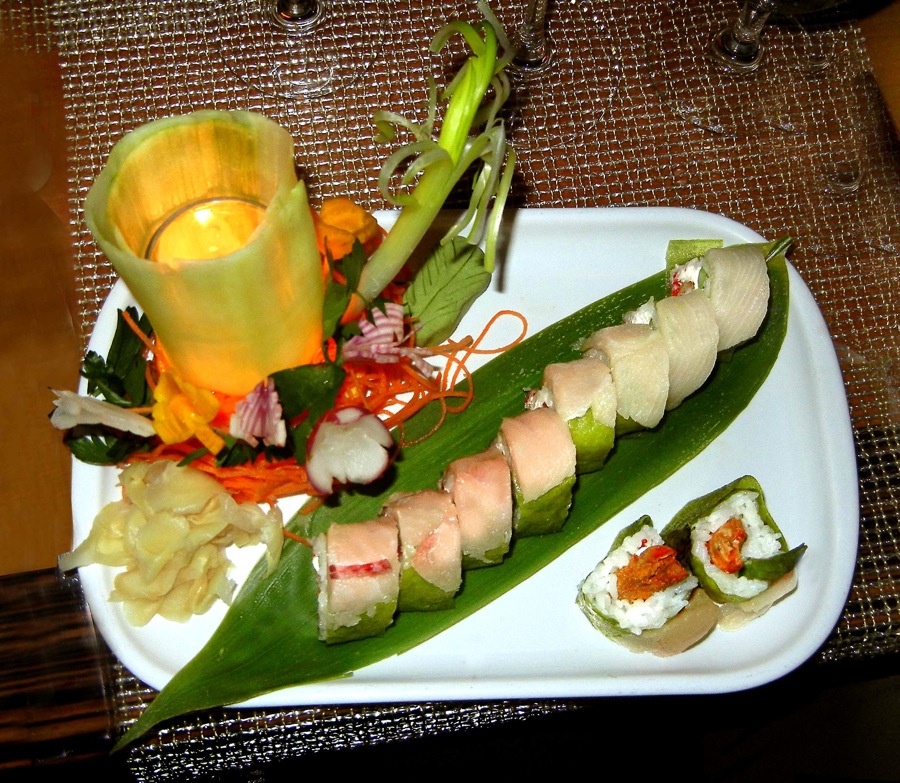 The waiter described
one of the night’s specials, a Paradise Roll (left), in glowing terms: the
sticky
rice studded with avocado, wasabi mayonnaise, and crunchy
shrimp
tempura, sliced into neat, bite-sized pieces. Grilled Colorado
lamb chops with roast
potatoes and a demi-glace proved once again why it’s the
best
lamb available, beautifully marbled, well-flavored, and fork-tender.
The
broiled snapper, served with deep-purple Okinawa potatoes in
their own
miniature casserole, broccolini and a Meyer lemon sauce --was
even
better for its lavish topping of crabmeat gratin.
The waiter described
one of the night’s specials, a Paradise Roll (left), in glowing terms: the
sticky
rice studded with avocado, wasabi mayonnaise, and crunchy
shrimp
tempura, sliced into neat, bite-sized pieces. Grilled Colorado
lamb chops with roast
potatoes and a demi-glace proved once again why it’s the
best
lamb available, beautifully marbled, well-flavored, and fork-tender.
The
broiled snapper, served with deep-purple Okinawa potatoes in
their own
miniature casserole, broccolini and a Meyer lemon sauce --was
even
better for its lavish topping of crabmeat gratin.
For dessert, a warm bread pudding with rum raisin ice cream, and banana caramel, was one of those sweet-on-sweet concoctions, that turn being over-the-top into an asset.
A
few words
with
eager, knowledgeable sommelier Roxane Shafaee-Moghadam, and we were
well
rewarded with a 2009 Evening Land Vineyards Pinot Noir ($65) from
Oregon’s
Willamette valley, the Eola-Amity Hills sub-appellation, to be precise.
Owner
Mark Tarlov makes about 3900 cases, with organic fruit from his
Seven Springs Vineyard, and with the help of consultant Dominique Lafon
of Domaine
des Comtes Lafon in Meursault, whose Burgundian approach is
evident in the
wine. Fruity, but without the jammy sweetness of some California
pinots, and
with just the right acidity for balance, it’s the winery’s entry-level
bottling.
Starters:
$ 11 to 18, entrees: 24 to 48, desserts: 6.50 to 7.50.
Back at the Main
building, The Seafood Bar is the place to go for flawless fish
in the
casual atmosphere of an old-Florida bungalow, with its vaulted,
open-beam
ceiling, plantation shutters and the ocean for a backyard. One dozen
Kumamoto, oysters,
medium-sized, with a subtle brininess and plump flesh, quickly
disappeared as
we looked over the menu. Appetizers proper were 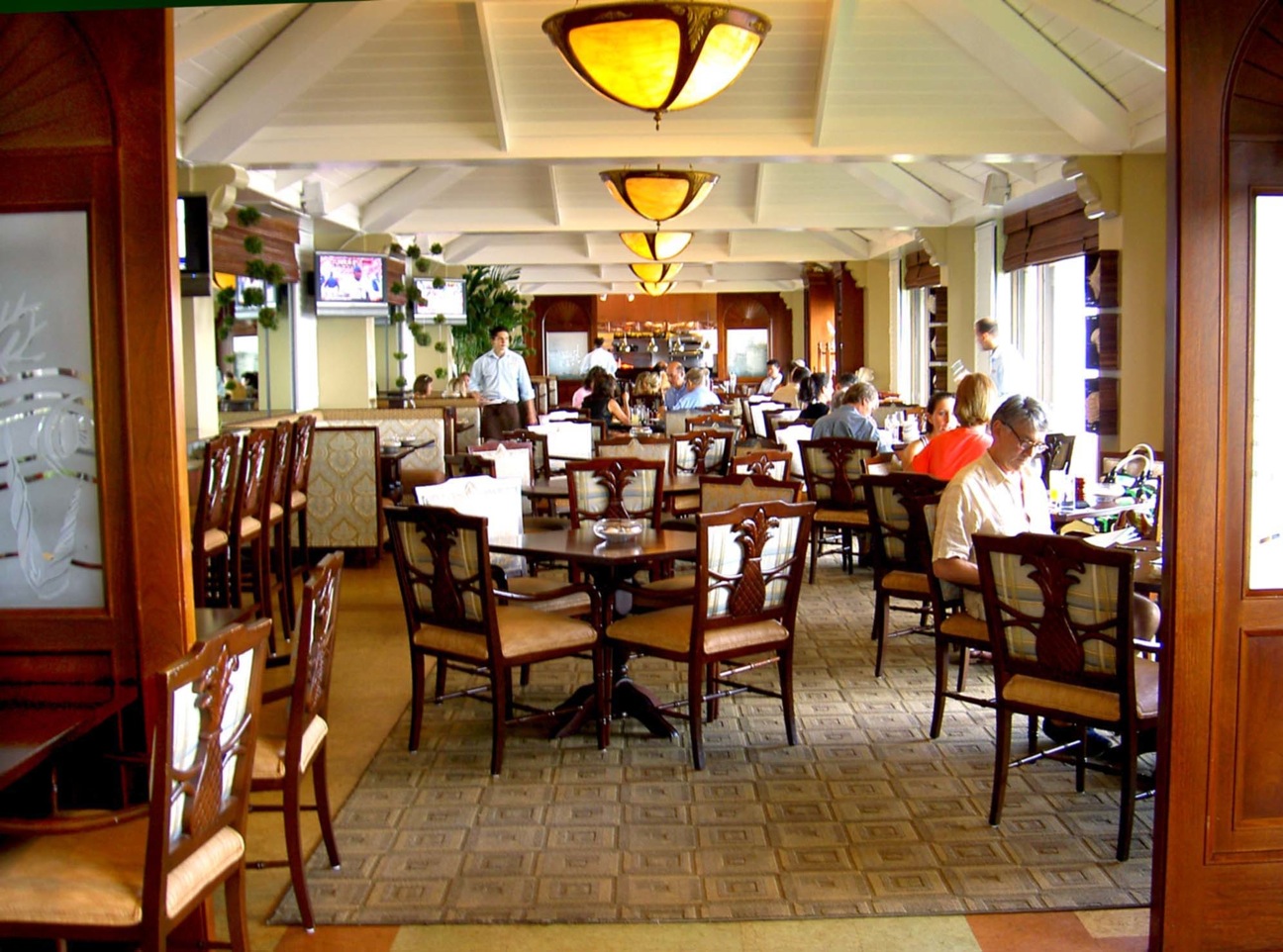 two jumbo stone
crab claws at $20 each, with a mustard/mayonnaise dipping sauce, and
shrimp and
grits with andouille sausage.
two jumbo stone
crab claws at $20 each, with a mustard/mayonnaise dipping sauce, and
shrimp and
grits with andouille sausage.
It’s
easy
to
see
why
stone
crabs
are
so
popular,
with big hunks of sweet
meat, easily removed from the
cracked claws, while the creamy, white cheddar grits and shrimp worked
well
together, especially with the occasional kick of spicy sausage. What
followed
were jumbo lump crab cakes with corn, tomato and haricots verts.
Three
medium-sized, almost pure crab cakes, with a nicely browned crust, and
a spicy remoulade sauce. The seafood club sandwich with Maine
lobster, and jumbo lump crab salad, on brioche with bacon and truffle
fries is
the
restaurant’s signature dish; well deserving of its star status, it’s a
big mound of
lobster/crab salad, with crisp bacon, on a tender brioche roll. What’s
not to
like?
Appetizers: $7.50 to $45, entrees: $21 to $63.
L’Escalier, the resort’s flagship restaurant, is for fine dining with all its luxurious accouterments. Chef de cuisine, Greg Vassos, combines contemporary flair and technical wizardry, with the time-honored traditions of the French kitchen, as well as the very best of ingredients, and ends up with the perfect blend of ultra-sophistication and good taste.
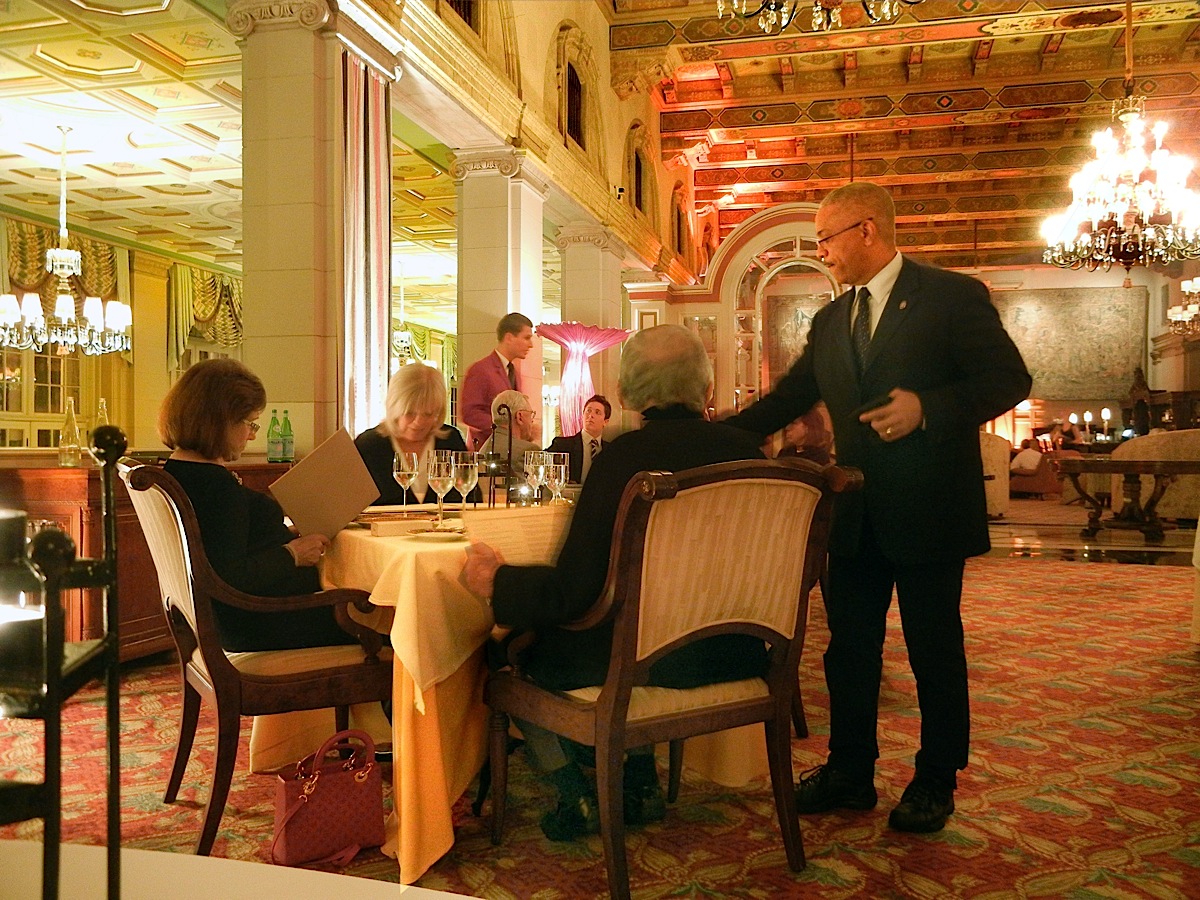 Who could resist a peekytoe crab “Mai Tai?” Hidden
demurely behind a green fan of sliced
avocado, the bashful crab was
served
alongside hearts of palm, a pool of “carbonated” guava, garnished with
coconut
“powder,” bits of fresh fig, Meyer lemon wedges, and small cubes of “compressed” fruits--resembling a
fruit-jelly but made in a totally different way. Each was carefully
placed in
a composition with the formal beauty of an abstract painting, as well
as the
random look of a group of exquisite, brightly-hued, jewel-like objects
that
just happened to have fallen, or been dropped, where they lay.
Who could resist a peekytoe crab “Mai Tai?” Hidden
demurely behind a green fan of sliced
avocado, the bashful crab was
served
alongside hearts of palm, a pool of “carbonated” guava, garnished with
coconut
“powder,” bits of fresh fig, Meyer lemon wedges, and small cubes of “compressed” fruits--resembling a
fruit-jelly but made in a totally different way. Each was carefully
placed in
a composition with the formal beauty of an abstract painting, as well
as the
random look of a group of exquisite, brightly-hued, jewel-like objects
that
just happened to have fallen, or been dropped, where they lay.
Perhaps Chef Vassos’ most playful dish is his Garden Landscape salad. Served on a square slab of slate, it’s a miniature potager with granulated porcini standing in for soil (I needlessly kept expecting grit until the final, gritless mouthful), covered with baby turnips, carrots, radishes and ears of corn that looked like they had just pushed through the earth. It’s a bit of whimsy, complete with potato “rake,” that I devoured to the very last bit. I’m not especially interested in the science behind powdering, compressing or carbonating foodstuffs, but the results here were delicious and visually arresting, with fresh flavors, and vivid colors. Chef Vassos has a very good eye, so no matter how fanciful the caprice, there’s no question that it’s food. The joke never goes too far; nor is the jest ever tasteless.
The
Foiewhopper, made
with Wagyu beef, Hudson Valley foie gras, Maine lobster, and
portabello mushroom
confit on a brioche roll in a pool of sauce périgueux
was another
tongue-in-cheek delight, combining three
of the most extravagant ingredients, the
“slider” gone completely upscale. 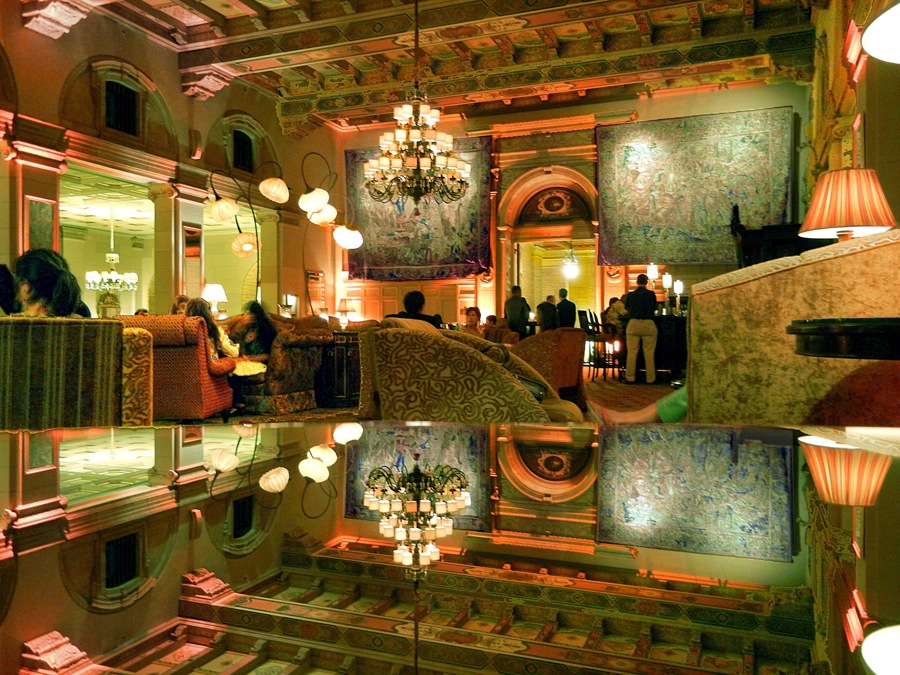
Raspberry sorbet atop a slice of pineapple confit performed well as a palate cleanser, and the single, multi-hued viola blossom used as garnish, provided a beautiful splash of color.
As tender as a cheek, the 48-Hour Prime beef, short-rib--so-called because it’s cooked sous-vide for two days--was bathed in a rich, brown, textbook sauce bordelaise worthy of Escoffier or Pellaprat. Alongside, on the square of white porcelain, were primeurs, Yukon potatoes confit, parsnip pudding, and mushrooms, all aligned in a beautiful burgundy swath, with once again just the right dosage of formal logic and random playfulness. Another beautifully wrought classic French staple turned on its head was the bouillabaisse sauce: bouillabaisse usually refers to the complete dish, the fish “stew,” and not to a free-standing sauce-- served alongside superb, wild Alaskan Halibut, with a squid ink risotto, compressed tomatoes, and perfectly-turned, Yukon potato cylinders used as receptacles for a trio of aïolis.
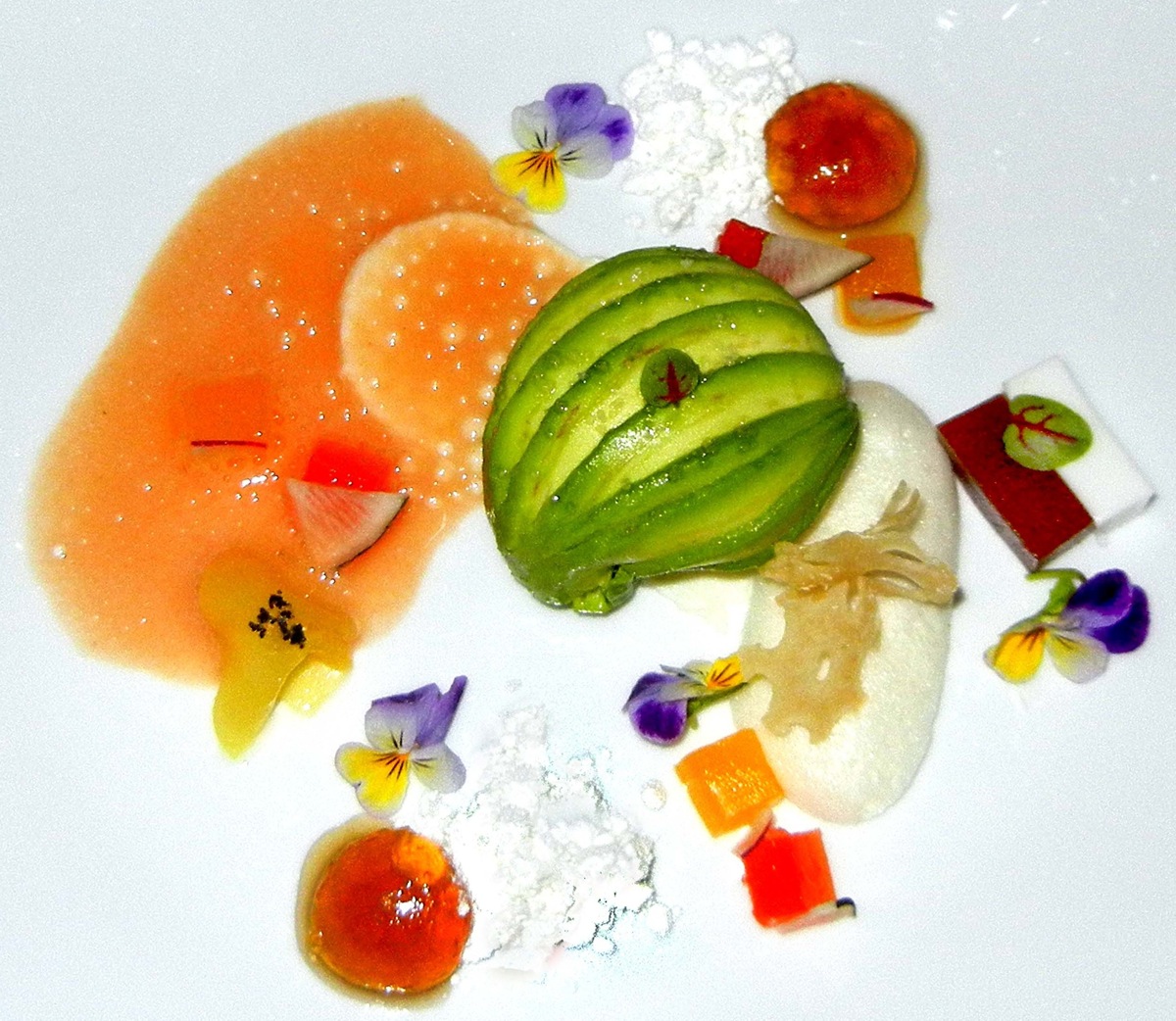
Our Assiette de
fromages finale deserves an article all its own. Époisses
de Bourgogne, from the Côte-d’Or, is
soft, creamy and pungent. Langa Rochetta is a fresh
Italian cheese,
cured no more than 8 to 10 days from the Piedmontese cheesemakers
Caseificio dell‘Alta
Langa. Ossau-Iraty, (unpasteurized)
made in the Pyrenées in two neighboring provinces, the Ossau
Valley in the
Béarn, and the wooded hills of Iraty in the French
Basque
country, and a delicious complex of flavors, and
Valdeon (cow,
goat) a semi-soft, blue-veined, from Posada de Valdeón, in
the
Northeast
province
of
Léon, a very good, tangy semi-soft blue,
well worth
searching out, that‘s assertive but not as strong as Cabrales because
the
Valdeón caves are a little drier.
Master
Sommelier,
Juan
Gomèz,
led
us
through
a
“flight”
of
delicious
wines, well-matched with the food: a
fresh,
tasty 2009 Louis Latour Santenay; a deeper, darker, richer
2005 Jean-Luc Colombo, Cornas; a
voluptuous
Château
2008
La
Gardine,
Châteauneuf-du-Pape,
and
a textbook red Burgundy, a step or two
above the
Santenay, made by Alex Gambal, a 2007 Cuvée les deux Papis, made
mainly
with
grapes
from
his
own
vineyard
in
Volnay.
First
courses: $17 to $26, $45 for the
“Foiewhopper,” main courses: $39 to $59.
NEXT WEEK, PART TWO: DINING BEYOND THE BREAKERS
A STAR CHEF FROM
ITALY
VISITS THE BIG APPLE
Finally, someone has succeeded in luring Chef Heinz Beck away from his kitchen in the Michelin three-star La Pergola restaurant (below) in Rome's Cavalieri hotel, bringing him to New York to cook, if only for a lunch and a dinner. Late June's gala dinner, held in the magnificent dix-huitième-style Conrad Suite on the fourth floor of the Waldorf-Astoria, clearly demonstrated why he is considered among the best and most interesting of contemporary chefs, and why even his second restaurant, Apsley's in London's Lanesborough hotel was so quick to gain its first Michelin star.
Beck's cooking is all about freshness, conceptual simplicity, and nutritional correctness, allied to an enormous respect for the ingredients. Painstakingly prepared, high quality, organic when possible components are made to yield up deep, precise, yet delicate flavors, while a wonderfully amiable desire, on the part of the chef to surprise adds a touch of the unexpected or unusual to beautiful, carefully thought out, yet unpretentious presentations. The food on the plate still looks like food. For Beck, the visual impact "is only the third part to a dish. The first is its creation, the second is how it tastes, and the third part is how it looks. If the taste of the dish isn't working, you're lost."
Chef Beck (right) is not the first Northern European to be drawn to the warmth and charms of Italy, where he emigrated from Germany in 1994, and to fall under the spell of its Mediterranean cuisine. Our meal that New York summer's evening was built along the lines of a classic Italian menu, with antipasti, followed by pasta, and then a piece of fish or meat, only here they doubled up on each course, i.e., two antipasti, two primi, and three secondi.
Amberjack
tartare
with
avocado
and
peach
was
a
good introduction to his style: fresh, clean
flavors,
delicate as a pastel, with the peaches giving an unexpected, yet
welcome twist. 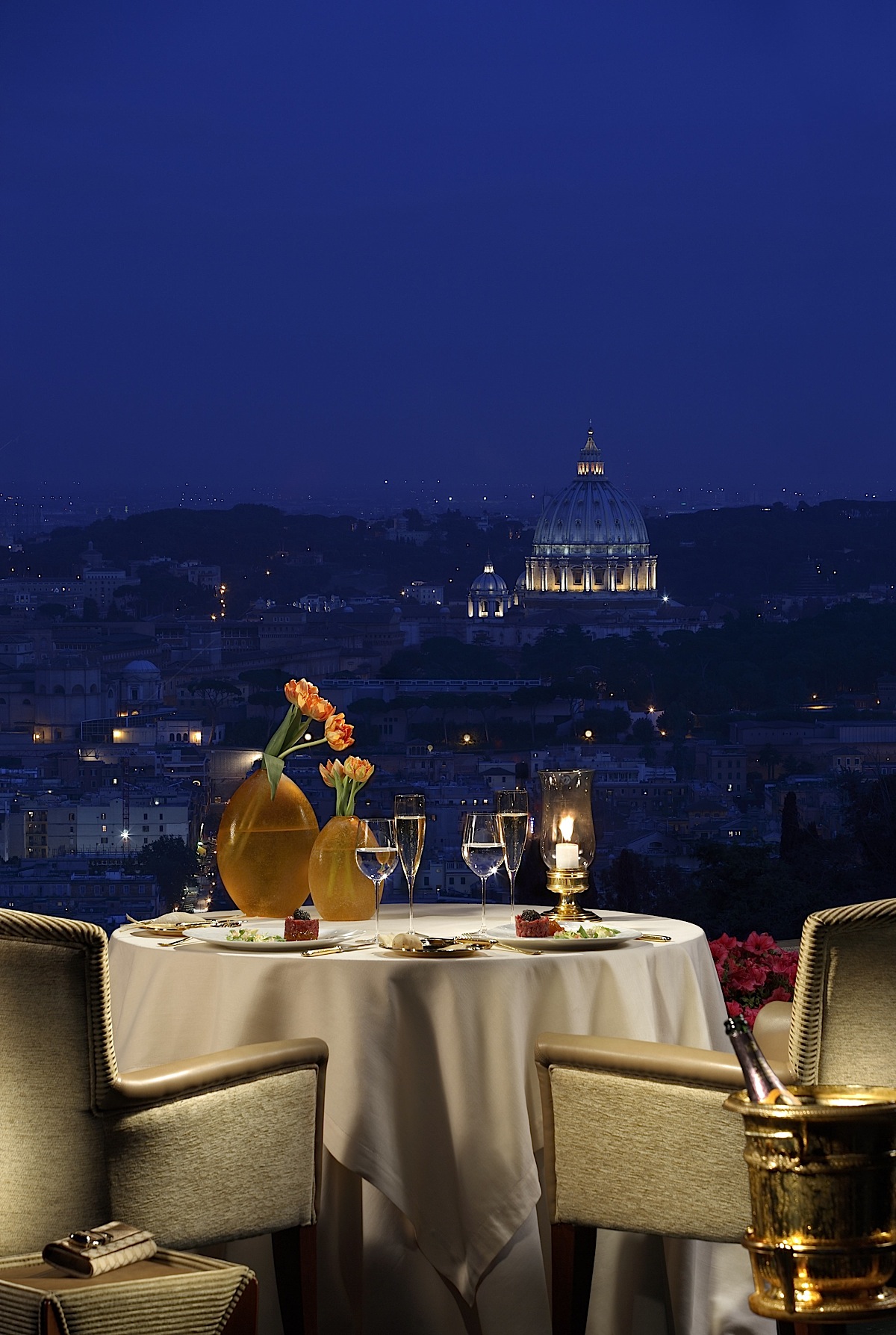 Scallop "veil" and
green
asparagus, with a tomato and basil vinaigrette came as a perfectly
seared sea
scallop and still slightly crisp, bright green, asparagus,was paired
with a
classic tomato and basil salad, and dressed with the most delicate,
delicious,
and precisely acidic vinaigrette I've ever tasted. The sheer
"veil" laying over the
spears of asparagus was cut with a very sharp knife from another sea
scallop,
inspired, perhaps, by the white marble sculptures of women, wrapped in
gossamer-like
veils that one occasionally runs into in an Italian church or gallery.
Scallop "veil" and
green
asparagus, with a tomato and basil vinaigrette came as a perfectly
seared sea
scallop and still slightly crisp, bright green, asparagus,was paired
with a
classic tomato and basil salad, and dressed with the most delicate,
delicious,
and precisely acidic vinaigrette I've ever tasted. The sheer
"veil" laying over the
spears of asparagus was cut with a very sharp knife from another sea
scallop,
inspired, perhaps, by the white marble sculptures of women, wrapped in
gossamer-like
veils that one occasionally runs into in an Italian church or gallery.
Beck also prepared one of his signature dishes, faggotelli alla carbonara (below)--fresh pasta pockets with a rich, creamy pecorino cheese filling, lightly glazed with a subtle veal stock --in place of the usual egg yolks-- along with bits of guanciale, grated pecorino, and freshly cracked Tellicherry pepper. It was easy to see why our First Lady, Michele Obama, considers this her favorite pasta dish. Maccheroncini al ferretto integrali (below, left), pasta shaped around a wire, ferretto, did nothing to further the cause of wholemeal pasta, being rather heavy and leaden, but the smoked eggplant coulis and gamberi rossi that accompanied it were excellent.
For
Beck,
the
contemporary
bias
in
favor
of
"scientific" haute cuisine has more to do
with the real science of nutrition, and the relationship between what
we eat
and how healthy we are than it does with using cutting-edge technology
and
esoteric, expensive gadgets 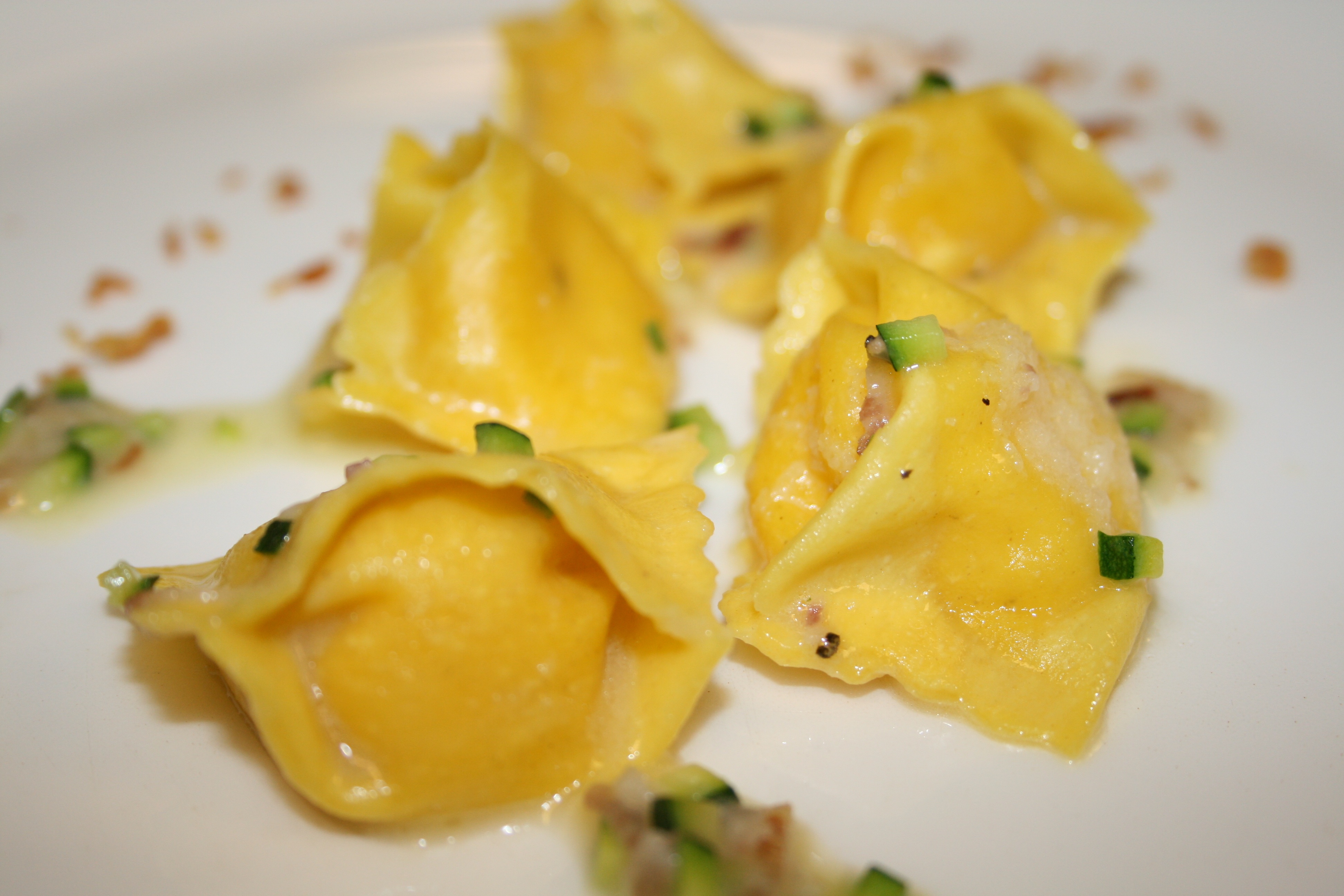 to work wonders, transforming baccalà into
"snow," for example. His cooking is more about nutritional validity,
than about alchemical wizardry. The Black cod with celery
sauce was a prime example, visually, nutritionally, and in terms of
flavor.
An utterly simple, completely transparent dish showcased the perfectly
grilled
piece of cod, sitting in a shallow pool of limpid, deeply-flavored,
broth. How
does he coax so much flavor out of celery?
to work wonders, transforming baccalà into
"snow," for example. His cooking is more about nutritional validity,
than about alchemical wizardry. The Black cod with celery
sauce was a prime example, visually, nutritionally, and in terms of
flavor.
An utterly simple, completely transparent dish showcased the perfectly
grilled
piece of cod, sitting in a shallow pool of limpid, deeply-flavored,
broth. How
does he coax so much flavor out of celery?
As
an
interlude
between
the
fish,
and
the
meat, course, we had a little of each: lobster and duck foie
gras on a bed of topinambour, or turnip, puree. Here the
Chef's
whimsy combined two extravagant, big-ticket items with turnips,
probably the
most "earthy"of the root vegetables--both in the sense of tasting of
the soil in which it grew, and that of
something
basic, down-to-earth (terre-à-terre), and dirt-cheap.
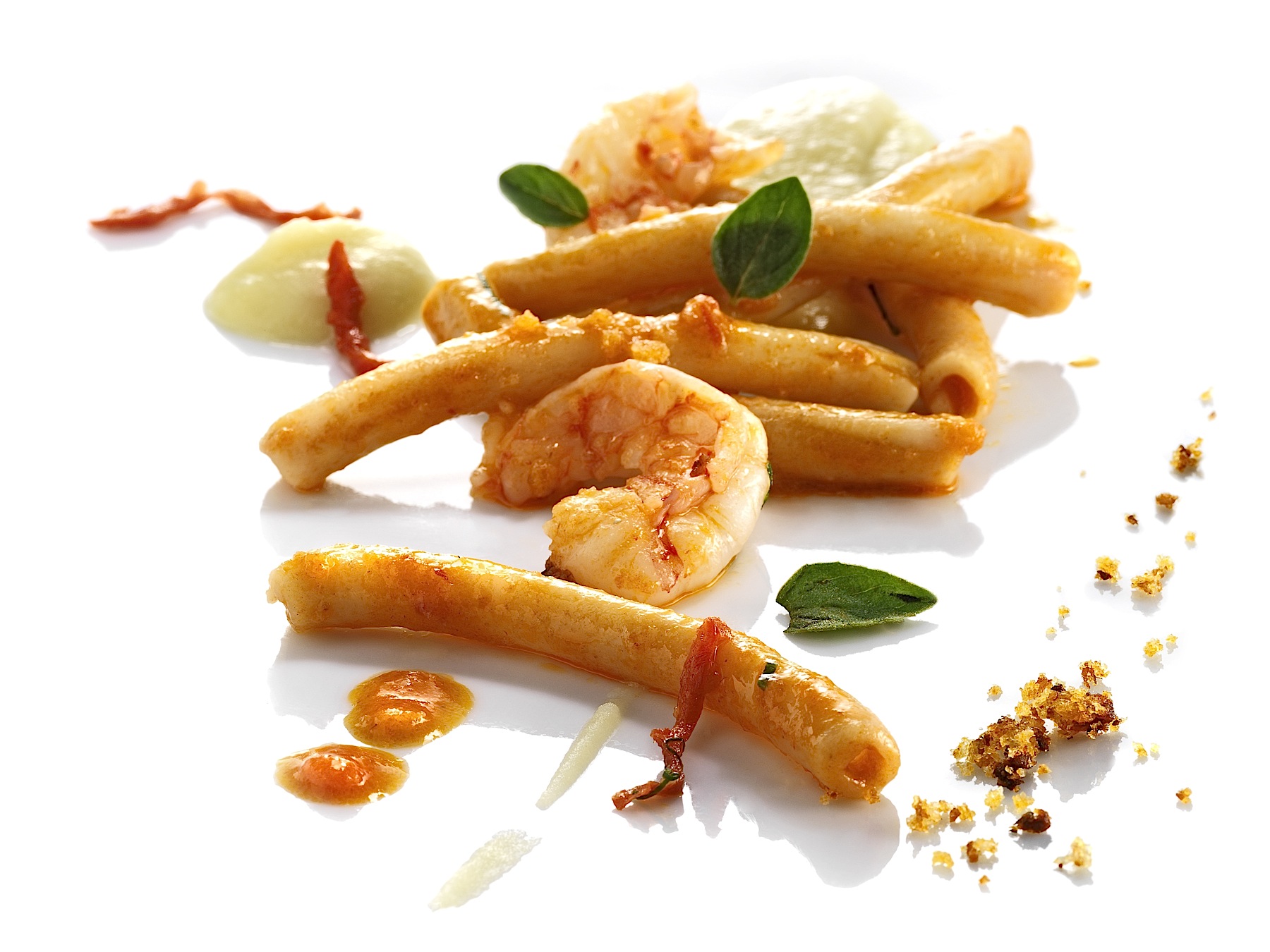 Bread-crusted lamb with artichokes finished off the savory dishes
with a quiet, yet resonant bang, the round of tasty, lean lamb, studded with a dice of artichoke, in a
crisp breadcrumb coating.
Bread-crusted lamb with artichokes finished off the savory dishes
with a quiet, yet resonant bang, the round of tasty, lean lamb, studded with a dice of artichoke, in a
crisp breadcrumb coating.
Dessert--apricot jelly with
bergamot ice cream--however, was disappointing. Whereas the dish was
lovely to
look at, and the bergamot ice cream delicious, the pool of apricot
"jelly," while intensely flavored, was rather unexciting, apricot
being one of the flavors that even commercially produced jellies get
right.
Perhaps, it was simply the lack of textural contrast.
Not that any intelligent person needs a reason other than Rome itself, to visit the city, but certainly a dinner at La Pergola--the dining room looks exquisite in pictures, and the views breathtaking--would be worth the trip all on its own. (Reservations must be made well in advance.) Thanks again to whoever was responsible for bringing Chef Beck to New York. Beck is also the author of several books on food, some of them translated into English from the original Italian.

MAN ABOUT TOWN
by
Christopher Mariani
Loudoun County, Virginia
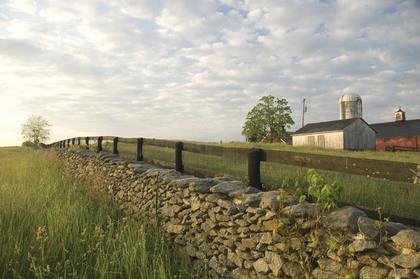
Goodstone
Inn
&
Estate Property
It
was
not
until the morning that I realized how
beautiful the Goodstone
property truly was. I had arrived at the estate
the
night before when darkness blanketed the landscape as we drove towards
the
Manor House (below). The
following day, after I filled my lungs with air
so crisp and
so clean, I walked gently down the squeaky wooden stairs so as not to
wake the others
in the house. Entering the living room I looked out towards 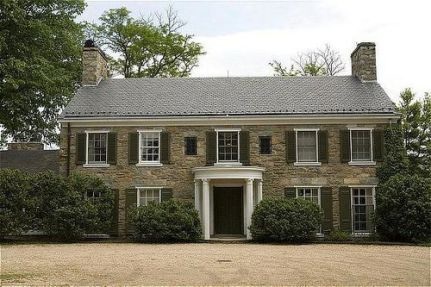 the back of
the
house and I saw the brightest green grass imaginable, scattered with
black cows
grazing while the morning sun glistened off their shiny damp backs. I
stepped
out onto the dew-moist stone patio and took another deep breath of the
cool crisp air.
The landscape was gentle, divided by a small stone wall that looked
like
an arched spine that started at the base of the hill and curved over
the top.
Each of the estate's six houses had only a handful of rooms,
each house connected by
a skinny gravel road. All roads led to the Main House where breakfast
was being
cooked by chef William Waldon.
the back of
the
house and I saw the brightest green grass imaginable, scattered with
black cows
grazing while the morning sun glistened off their shiny damp backs. I
stepped
out onto the dew-moist stone patio and took another deep breath of the
cool crisp air.
The landscape was gentle, divided by a small stone wall that looked
like
an arched spine that started at the base of the hill and curved over
the top.
Each of the estate's six houses had only a handful of rooms,
each house connected by
a skinny gravel road. All roads led to the Main House where breakfast
was being
cooked by chef William Waldon.
After
arriving
at
the
Main
House
I
grabbed
a small table in the corner and was
immediately poured a steaming hot cup of dark brown coffee and offered
either
fresh squeezed orange juice or grapefruit juice. The sun was shining
through
the windows and the chandelier above reflected light all throughout the
room.
The dining room (below) was
lovely, covered from head to toe in dark wood and
each
table elegantly draped by a white cloth. I ordered an omelet
filled with
chopped ham, onions, peppers and cheese. Chef also insisted I try his
famous
blueberry pancakes. They were stacked high, about a quarter inch thick,
made
with fresh blueberries that oozed into the cornmeal pancakes when
broken and
each bite had a rich buttery flavor. After one more 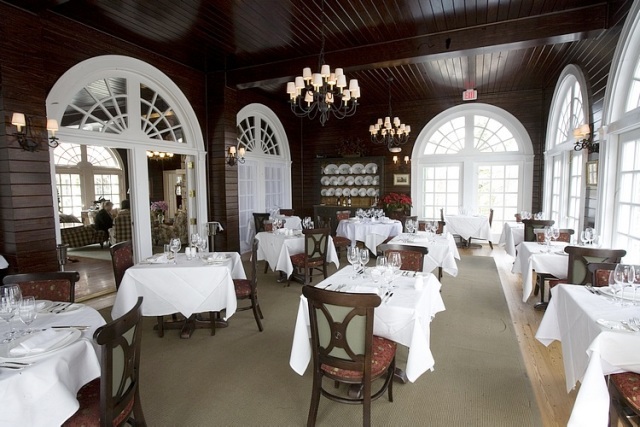 cup of coffee I was
off to
the charming little town of Leesburg.
cup of coffee I was
off to
the charming little town of Leesburg.
Leesburg
is
centered
around
one
main
drag
and
a few streets that jut off on either
side.
There are some decent spots to grab lunch but nothing worth a detour
and a slew
of antique shops placed around almost every corner.
That
afternoon we stopped by the Sunset Hills Vineyard for a wine tasting.
Like most
Virginia wineries, all wine produced on property is sold on property
during tastings and tours. Very few vineyards in Virginia actually
mass-produce and
sell to outside vendors. Though wine connoisseur Thomas Jefferson toyed
with the idea of grape plantings, in the 18th century, the
state's wine scene is young and needs much
improvement, but I did taste some wines that proved to have much
potential. Like
any new art form, wine making takes time to perfect and I foresee
Virginia
wines coming around in the next five to ten years. Where California
wines were in the 1970s, Virginia's are now, and that's impressive.
 That
evening we dined at Goodstone, where chef Waldon prepared a wonderful
meal. The
dining room at night time is as romantic as one could wish for, a dim
cast,
tables topped with burning candles, beautiful stemware and Herman
Hupfeld’s “As
Time Goes By” playing softly in the background. I started with a wild
mushroom
crêpe stuffed with an array of different mushrooms; shiitake,
Hedgehog, Oyster and
Hen of the Woods, covered by a creamy truffle sauce. There is also foie
gras
sushi, a combination of sashimi grade tuna and seared duck foie gras, a
unique dish
but the fatted liver and fish would have tasted much better
on their own. Main courses included a traditional order of Maryland
crab cakes,
top selections of beef and seasonal birds. Desserts all looked good but
I
couldn’t resist chef’s chocolate soufflé sided by a hot
crème anglaise sauce.
That
evening we dined at Goodstone, where chef Waldon prepared a wonderful
meal. The
dining room at night time is as romantic as one could wish for, a dim
cast,
tables topped with burning candles, beautiful stemware and Herman
Hupfeld’s “As
Time Goes By” playing softly in the background. I started with a wild
mushroom
crêpe stuffed with an array of different mushrooms; shiitake,
Hedgehog, Oyster and
Hen of the Woods, covered by a creamy truffle sauce. There is also foie
gras
sushi, a combination of sashimi grade tuna and seared duck foie gras, a
unique dish
but the fatted liver and fish would have tasted much better
on their own. Main courses included a traditional order of Maryland
crab cakes,
top selections of beef and seasonal birds. Desserts all looked good but
I
couldn’t resist chef’s chocolate soufflé sided by a hot
crème anglaise sauce.
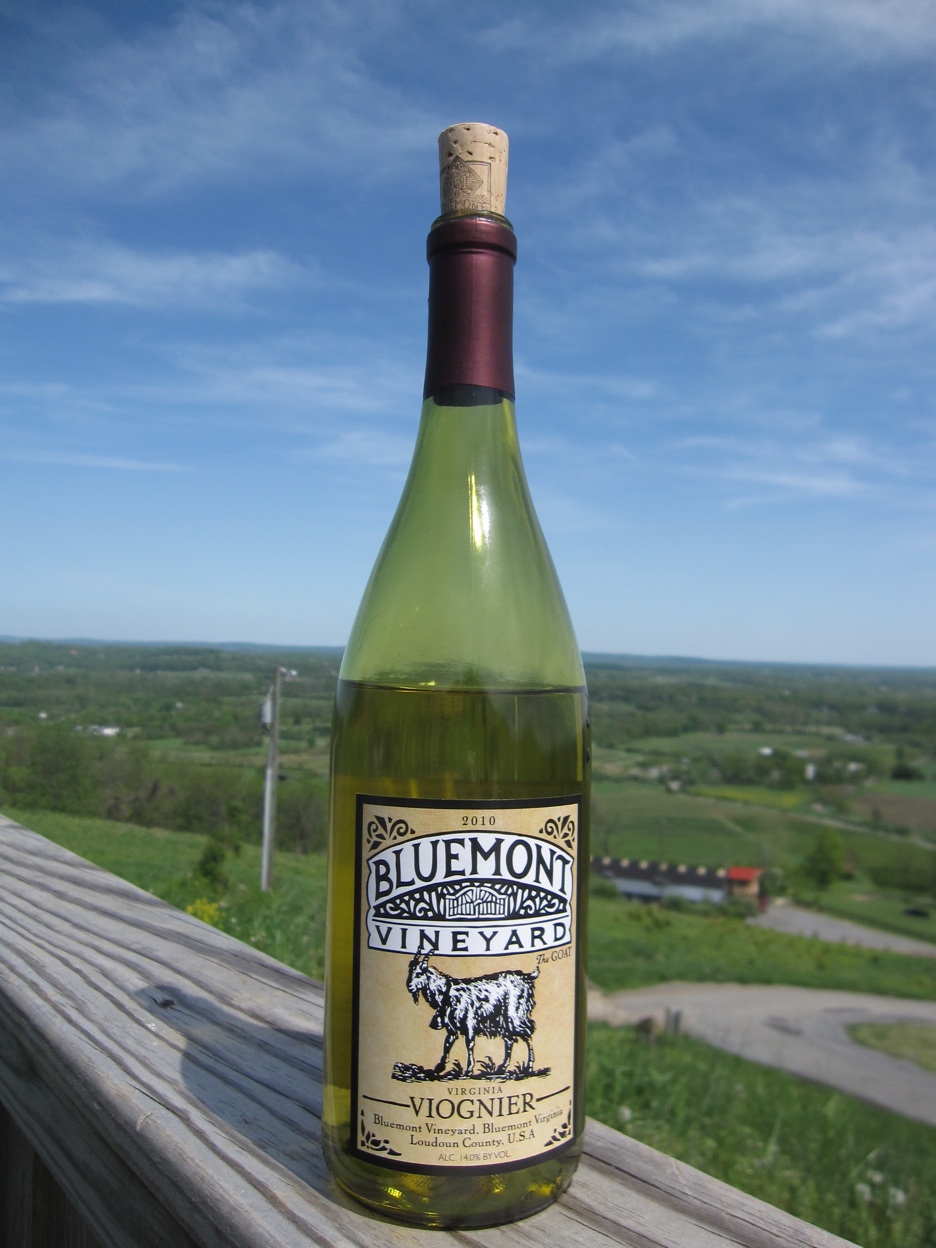 The
following day I visited one the most stunning vineyards I’ve ever seen,
Blumont
Vineyards, perched 1,000 feet high above the Virginia countryside. To
get
to the
vineyard you must drive up a steep windy slope before arriving at the
house
where live music plays and picnic tables are set up for guests to enjoy
wine
and a quick bite. The wine is nothing to write home about but the
overall
experience is blissful. The sun shines down as a cool breeze wisps by
while
locals sit around drinking and tasting different wines, laughing and
enjoying
such a magnificent view. Blumont Vineyards, like many Long Island
vineyards are
typical party wineries that only sell on property and are perfectly
content
doing so. The parking lot had at least three or four limos present,
dropping
off bachelorette parties.
The
following day I visited one the most stunning vineyards I’ve ever seen,
Blumont
Vineyards, perched 1,000 feet high above the Virginia countryside. To
get
to the
vineyard you must drive up a steep windy slope before arriving at the
house
where live music plays and picnic tables are set up for guests to enjoy
wine
and a quick bite. The wine is nothing to write home about but the
overall
experience is blissful. The sun shines down as a cool breeze wisps by
while
locals sit around drinking and tasting different wines, laughing and
enjoying
such a magnificent view. Blumont Vineyards, like many Long Island
vineyards are
typical party wineries that only sell on property and are perfectly
content
doing so. The parking lot had at least three or four limos present,
dropping
off bachelorette parties.
Civil War
history bursts through in every town and restored plantations
are a must visit if not for their history at least for their sheer
splendor.
There also a great pie shop in Leesburg called the Mom’s Apple Pie (above) that
serves
up a cherry pie easily worth an hour drive.
Loudoun
County
sure
surprised
the hell out of me as one of the most gorgeous
rural counties
in America. Only a one-hour drive from DC and a one-hour flight from
NYC,
Loudoun County is sure to be a weekend destination for those who
appreciate
beauty.
Live music at Blumont Vineyards
To contact Christopher Mariani send an email to christopher@johnmariani.com.
HENNESSEY'S $5 MILLION NOSE
by Mort Hochstein
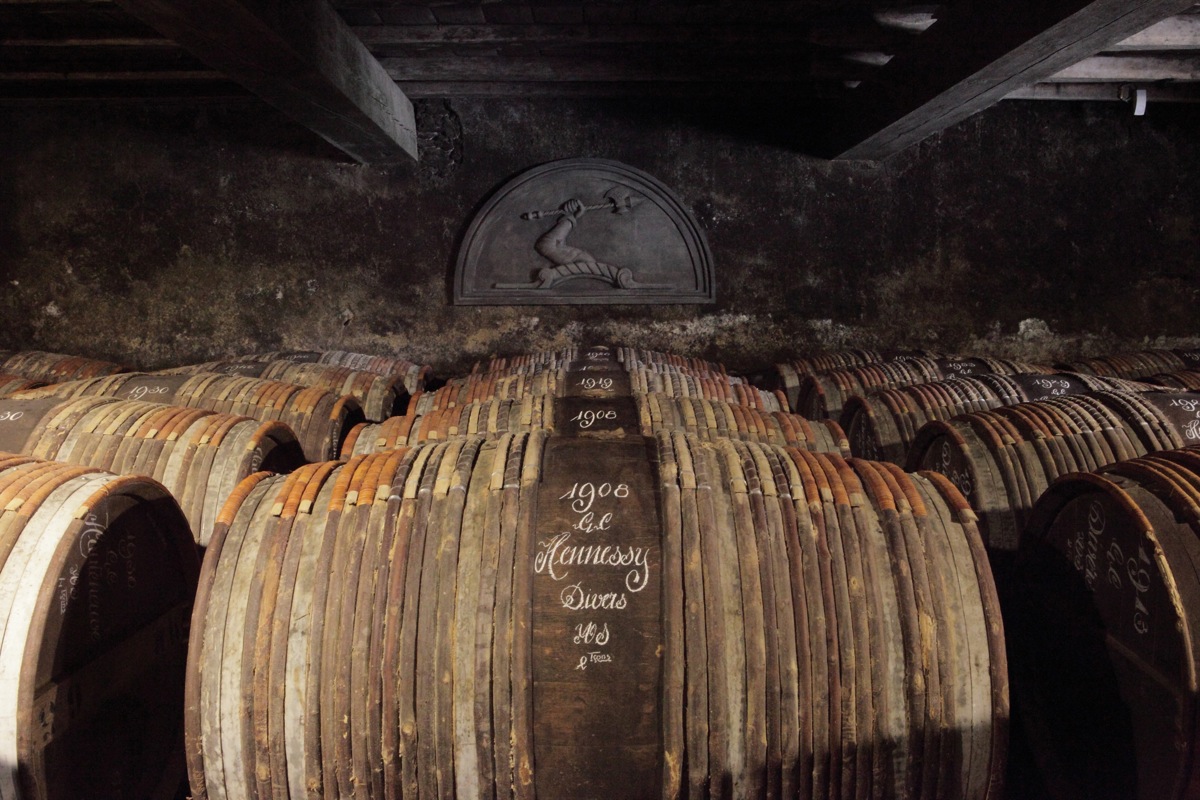 Back in the
seventies, food journalist
Roy Andries De Groot suggested that Hennessy should insure the nose of
Maurice Fillioux for five million
dollars, since his olfactory skills were so vital to
the
success
of
the
Cognac
firm.
Fillioux
was the sixth generation member
of a family of master
blenders who have created fine
Cognacs for the
Hennessy family from the firm’s earliest days, more than two centuries
ago.
Back in the
seventies, food journalist
Roy Andries De Groot suggested that Hennessy should insure the nose of
Maurice Fillioux for five million
dollars, since his olfactory skills were so vital to
the
success
of
the
Cognac
firm.
Fillioux
was the sixth generation member
of a family of master
blenders who have created fine
Cognacs for the
Hennessy family from the firm’s earliest days, more than two centuries
ago.
I
was
with
De
Groot
when
he
interviewed
Fillioux
at
Bagnolet,
Hennessy’s guest house, and I recalled that extravagant
proposal as I
talked to Yann Fillioux, seventh generation master blender for Hennessy. Things were somewhat different in his
uncle’s times, when blending depended more on the skill of one man. Yann
Fillioux
in
he
21st century sounds
more
like
the
coach
or
captain
of
a
football
team
as he describes the
teamwork required for the selection
of the
spirits –eau de vie is the correct term—that are melded into the final
blend.
Fillioux (below) and his group must produce Cognac indistinguishable from a blend produced half a century ago or another half century into the future. “Continuity is essential. Those who follow me, “ Fillioux emphasizes, “will judge the success of our efforts, just as we evaluate and work with Cognacs blended by those who preceded us.”
Team Fillioux 2011 has eight tasters, two
in their
sixties, two in their fifties, two in their forties and two in their
thirties. They
gather each day in a room that
could be called a library of spirits, its walls lined with
shelves bearing several hundred apothecary vials, the spirits in them ascending from clear young distillates
to the dark amber color 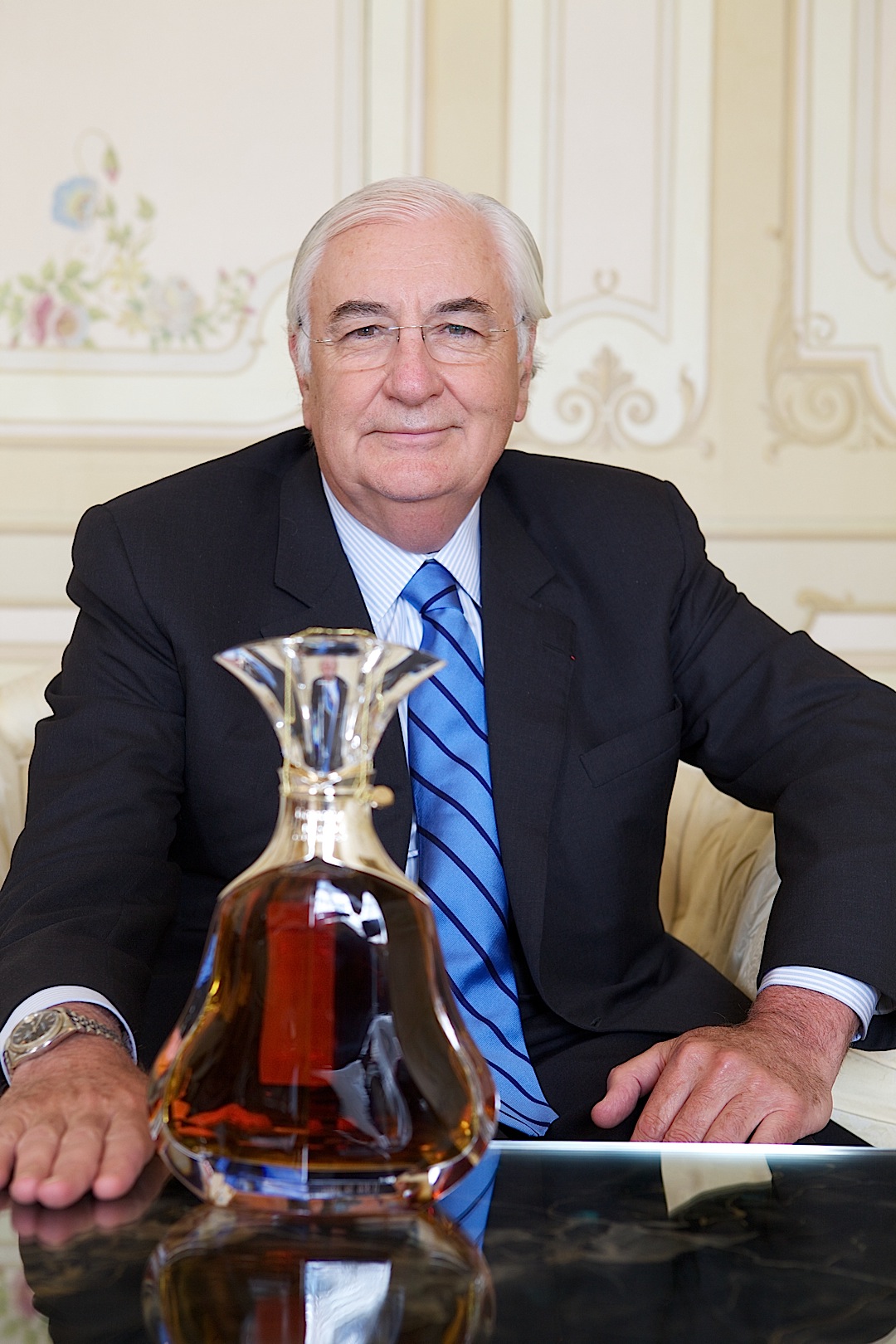 that
signifies advancing maturity, many first
sampled and evaluated by earlier
generations of the Fillioux clan. “You must
taste in the same
room at the same time with the same people. Consistency is important,”
the
cellar master declares. “Members
of
the
tasting
committee,"
he
says,
smiling
broadly,
“must
be
with us for ten years before they are allowed to speak.” In their
daily
meetings, each morning at 11:30, they sample dozens of
spirits, tasting, discussing and
tasting again the eaux de
vie, sampling from some 1,000 vials each year, Their task is
twofold—to identify the qualities of each eau de vie and to create a
memory
toward the assemblage of a perfect
blend. One of the younger members in that group is yet another
generation of
the Fillioux clan, preparing for his time in the center chair.
that
signifies advancing maturity, many first
sampled and evaluated by earlier
generations of the Fillioux clan. “You must
taste in the same
room at the same time with the same people. Consistency is important,”
the
cellar master declares. “Members
of
the
tasting
committee,"
he
says,
smiling
broadly,
“must
be
with us for ten years before they are allowed to speak.” In their
daily
meetings, each morning at 11:30, they sample dozens of
spirits, tasting, discussing and
tasting again the eaux de
vie, sampling from some 1,000 vials each year, Their task is
twofold—to identify the qualities of each eau de vie and to create a
memory
toward the assemblage of a perfect
blend. One of the younger members in that group is yet another
generation of
the Fillioux clan, preparing for his time in the center chair.
Seated behind a desk empty of paperwork, topped only by a crystal Baccarat decanter, Fillioux scoffed when I asked if he ever wore the bleu de travail, the traditional working uniform of French laborers. “No, never,” he responded emphatically. “Our uniform here is a tie and suit, although," he added quickly, “I occasionally wear, what is it, a sport jacket? I wear a blazer.”
The official grades of Cognac are VS (Very
Special, where the youngest brandy rests at least two years in wood;
VSOP (Very
Special Old Pale, whose youngest spirit spends at least four years in a
cask),
and the top of the line X.O, Extra Old, which contains as many as 100
eau de
vie, the youngest at least six years old. Complex
and
elegant,
X.O. sells for abut $150. And
then
there are the super premiums, dressed in designer decanters that add to
their allure, such as Paradis, which retails for about $800 and
Hennessy Richard,
about $3500, honoring founder Richard 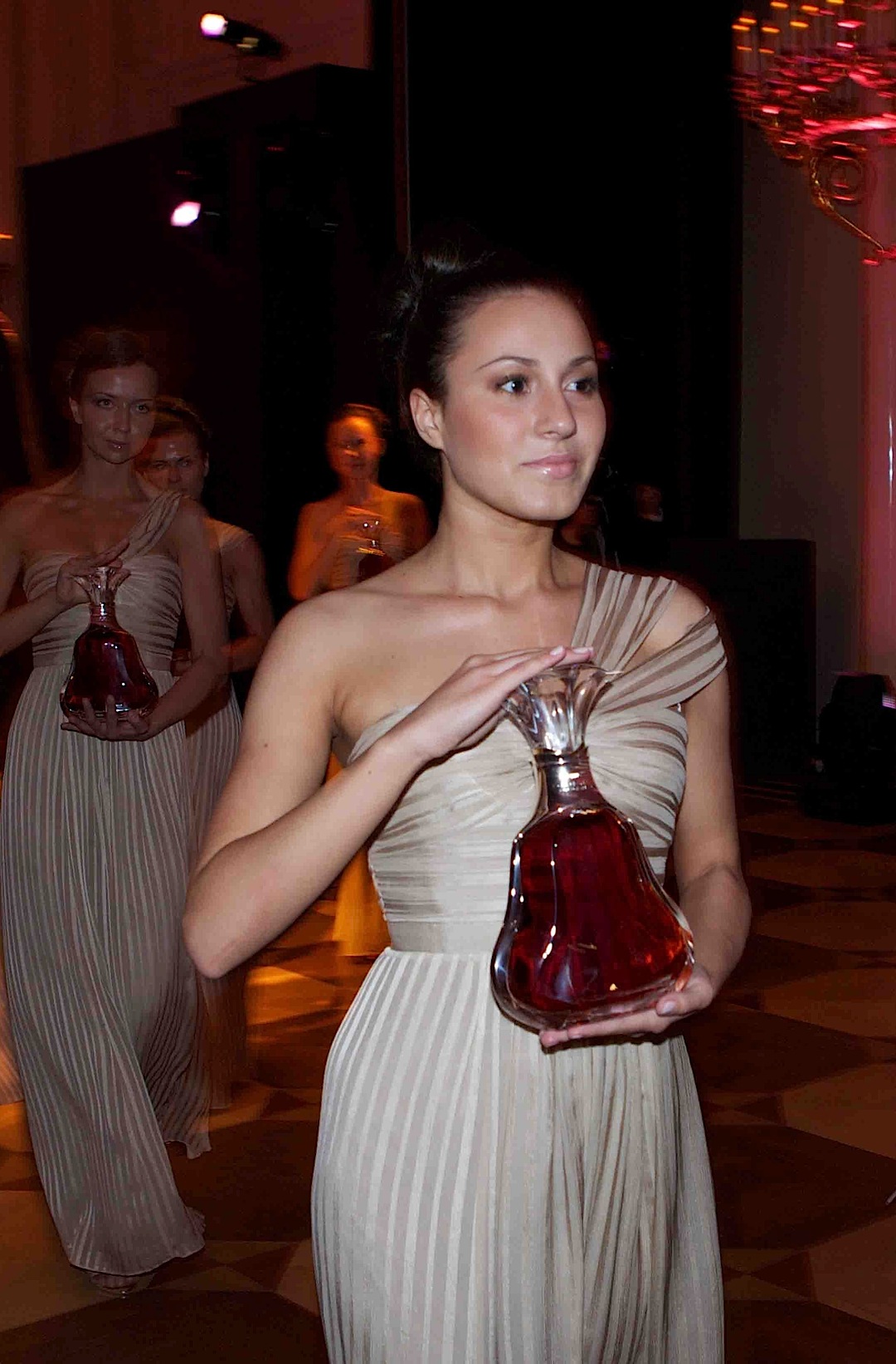 Hennessey. Prices
vary wildly in the marketplace and shoppers often find themselves competing
with collectors who snap up the latest spirit, since they are usually
limited
bottlings. The market is
now especially hot in China, which is Hennessy’s largest dollar volume
outlet,
although the United States buys in greater quantities.
Hennessey. Prices
vary wildly in the marketplace and shoppers often find themselves competing
with collectors who snap up the latest spirit, since they are usually
limited
bottlings. The market is
now especially hot in China, which is Hennessy’s largest dollar volume
outlet,
although the United States buys in greater quantities.
Paradis Imperial, ($2,200) like previous special blends, comes with a story. In 1818, the well-traveled Dowager Empress of Russia, Maria Feodorovna, implored Hennessy to create “a cognac of excellent, very old, gold colored” eau de vie as a gift for her son, Czar Alexander. The story of the spirit that Hennessy assembled for Russian nobility came down from Jean Fillioux in the 19th century to Yann Fillioux in the 21st and he decided to create a limited edition Cognac memorializing that earlier achievement.
He was, fortunately, able to dig deep into the Hennessy Founders Cellar for treasured eaux de vie dating back to the 1800’s. In his words “This cognac is the fruit of generations of talents. I inherited outstanding eaux de vie produced by previous generations of my family, who foresaw an exceptional future for them. This cognac is their creation.”
Hennessy launched Paradis Imperial this
spring in festivities at the fabled Hermitage Museum and the Marble
Palace in
St. Petersburg (left), once
the capitol of Russian aristocracy. Opera singes
and
dancers from
the
Mariinsky
Theater
recreated
the
elegance
of
the
Imperial
Court
before
an audience of international notables. The
gathering
included
several Chinese
celebrities, a
tribute to the burgeoning importance of China as a market for upscale
Cognac.
Paradis Imperial will be launched next summer in the U.S. and it will arrive
bearing a $2,200
price tag. It is quite likely that the greater share of the limited
bottling
will go to China.
❖❖❖
GOOD FRIENDS DON'T LET FRIENDS SHOOT UP THE PLACE
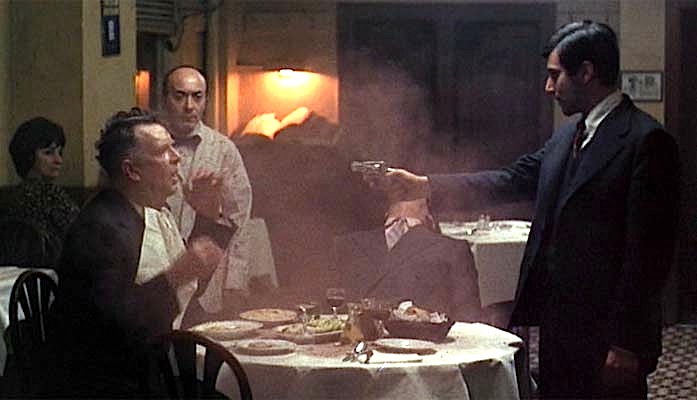
The Ohio General Assembly passed a law allowing residents to carry concealed handguns into bars and other licensed establishments in the state, including shopping malls and sporting venues. Businesses can continue to ban concealed weapons on their premises for safety reasons, like the Cincinnati Bengals football team, which continues to bar firearms in their stadium. The law does prohibit gun owners from consuming alcohol or being under the influence of alcohol or drugs when toting their weapons into bars.
ONE MORE REASON
TO MOVE TO LONDON
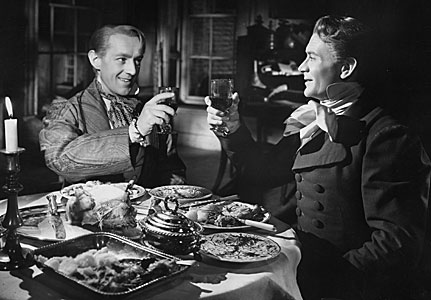
“New Yorkers are infinitely more social. In London, chaps demurely nod at each other across
 the room, while
New Yorkers are hugging and
slapping each other’s backs—they seem to enjoy themselves so much more.”-- Jeremy King of NYC's
Monkey Bar, in Travel & Leisure.
the room, while
New Yorkers are hugging and
slapping each other’s backs—they seem to enjoy themselves so much more.”-- Jeremy King of NYC's
Monkey Bar, in Travel & Leisure.
❖❖❖
Any of John Mariani's books below
may be ordered from amazon.com.
" A fact-filled,
entertaining history [that] substantiates its title with hundreds of
facts in this meaty history of the rise of Italian food culture around
the
globe. From Charles Dickens's journey through Italy in 1844 to
20th-century
immigrants to America selling ice cream on the streets of New Orleans,
Mariani
constantly surprises the reader with little-known culinary anecdotes
about
Italy and its people, who have made pasta and pizza household dishes in
the
U.S. and beyond."--Publishers Weekly "Equal
parts
history,
sociology,
gastronomy,
and
just
plain
fun,
How
Italian
Food
Conquered
the
World
tells
the
captivating
and
delicious
story
of
the
(let's
face
it)
everybody's
favorite
cuisine
with
clarity,
verve
and
more
than
one
surprise."--Colman
Andrews,
editorial
director
of
The
Daily Meal.com. "A
fantastic and fascinating read, covering everything from the influence
of Venice's spice trade to the impact of Italian immigrants in
America and the evolution of alta cucina. This book will serve as a
terrific resource to anyone interested in the real story of Italian
food."--Mary Ann Esposito, host of PBS-TV's Ciao Italia. "John
Mariani
has
written
the
definitive
history
of
how
Italians
won
their
way
into
our
hearts,
minds,
and
stomachs.
It's
a
story
of
pleasure
over
pomp
and
taste
over
technique."--Danny
Meyer,
owner
of
NYC
restaurants
Union
Square
Cafe,
Gotham
Bar
&
Grill,
The
Modern,
and
Maialino.
|
 |
 |
 |
 |
 |
 |
 |
 |
 Everett
Potter's
Travel
Report:
Everett
Potter's
Travel
Report: 
 Eating
Las
Vegas is the new on-line site for Virtual Gourmet
contributor John
A. Curtas., who since 1995 has been commenting on the Las Vegas food
scene and reviewing restaurants for Nevada Public Radio. He is
also
the restaurant critic for KLAS TV, Channel 8 in Las Vegas, and his past
reviews can be accessed at KNPR.org.
Click
on
the
logo
below
to
go
directly
to
his
site.
Eating
Las
Vegas is the new on-line site for Virtual Gourmet
contributor John
A. Curtas., who since 1995 has been commenting on the Las Vegas food
scene and reviewing restaurants for Nevada Public Radio. He is
also
the restaurant critic for KLAS TV, Channel 8 in Las Vegas, and his past
reviews can be accessed at KNPR.org.
Click
on
the
logo
below
to
go
directly
to
his
site.

Tennis Resorts Online: A Critical Guide to the World's Best Tennis Resorts and Tennis Camps, published by ROGER COX, who has spent more than two decades writing about tennis travel, including a 17-year stretch for Tennis magazine. He has also written for Arthur Frommer's Budget Travel, New York Magazine, Travel & Leisure, Esquire, Money, USTA Magazine, Men's Journal, and The Robb Report. He has authored two books-The World's Best Tennis Vacations (Stephen Greene Press/Viking Penguin, 1990) and The Best Places to Stay in the Rockies (Houghton Mifflin, 1992 & 1994), and the Melbourne (Australia) chapter to the Wall Street Journal Business Guide to Cities of the Pacific Rim (Fodor's Travel Guides, 1991).


The Family Travel Forum
- A community for those who
"Have Kids, Still Travel" and want to make family vacations more fun,
less work and better value. FTF's travel and parenting features,
including
reviews of tropical and ski resorts, reunion destinations, attractions,
holiday
weekends, family festivals, cruises, and all kinds of vacation ideas
should be
the first port of call for family vacation planners. http://www.familytravelforum.com/index.html
ALL YOU NEED BEFORE YOU GO


MARIANI'S VIRTUAL GOURMET NEWSLETTER is published weekly. Editor/Publisher: John Mariani.
Contributing Writers: Christopher
Mariani, Robert Mariani,
John A. Curtas, Edward Brivio, Mort
Hochstein, and
Brian Freedman. Contributing
Photographers: Galina Stepanoff-Dargery, Bobby Pirillo. Technical
Advisor:
Gerry McLoughlin.
© copyright John Mariani 2011

